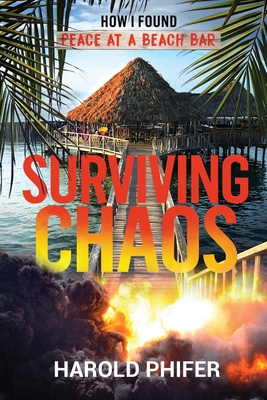Surviving Chaos, How I Found Peace at A Beach Bar by Harold Phifer Book Reviewed
by Denolyn Carroll
Publication Date: Feb 18, 2021
List Price: $17.95
Format: Paperback, 250 pages
Classification: Nonfiction
ISBN13: 9780578743547
Imprint: Rise & Read Free Press
Publisher: Rise & Read Free Press
Parent Company: Rise & Read Free Press, LLC
Borrow from Library
Book Reviewed by Denolyn Carroll
Read the publisher’s description.
From its Introduction to its Epilogue, Surviving Chaos explodes with details of a life lived on the edge of endurance. While laying low in Thailand, Harold Phifer, Mississippi-born and bred, connects with Dylan, a seventy-something retired banker from New York. Initial guarded observations give way to a measured conversation at a beach bar that results in Harold unearthing “the sad stories that glued [him] together.” These interrelated short stories are contained in a nine-part memoir that, as Harold explains in his introduction, “touches on the sad, the shocking, and the schizophrenic behaviors that surrounded me until well into adulthood…[giving] a raw peek into what it’s like to be raised by a mentally ill mother and a greedy, calculating aunt. My childhood and my career contained chaotic events.”
The door to these hidden memories is blasted open by “a near-death experience from a terrorist’s attack in Afghanistan,” where Harold, a specialized air traffic controller, is working as an international contractor. As his fifty-six years flash before his eyes, we deep-dive with him into his early years, getting a glimpse of the most constant igniting elements of his young life: his mom, Eliza (aka “That Crazy Bicycle Lady” —“as potent and powerful as a nuclear bomb”), his brother Jerry (“the family’s crowned jewel”), and Aunt Kathy (“the warden of the asylum” that is his home).
As the stories unfold, we learn of a childhood steeped in family dysfunction, abject poverty, emotional abuse, betrayals, gut-wrenching losses, and more. Even the freedom Harold anticipates when he starts college is tenuous at best. In early adulthood he faces racism on a level that seeks to wrestle from his grasp the career he worked so hard to solidify despite the odds stacked against him. But, to his credit, he survives it all, pushing his blighted past into the secret caverns of his mind in the process. And when work takes him to Iraq and Afghanistan, one can only surmise that his training for these blast zones had started from birth.
Harold relates profoundly painful memories with touches of humor—a key element for any survival strategy. Story titles such as “My Thank-less Thanksgiving Dinner,” “Tales of a Fourth-Grade Nothing,” “Moving On Up, to the Projects,” “The Car Made Me Do It,” and “An Opossum is Still a Possum” are just a few indicators of the engaging narratives that await readers.
From “Part1: Blast to the Past,” “Part II: Dysfunction Junction,” to “Part V: High School is Not for the Weak,” “Part VII: Memphis Blues,” to “Part IX: Off to Other Wars,” the vignettes in Surviving Chaos are divided into nine sections. The blast in Afghanistan is the starting point and provides the thread for the stories that fall through the pages of the book like well organized bits of shrapnel. The lead-in to each part deftly maintains the focus and pace of the memoir. Prior to Part I, the short chapter that follows the Introduction ends with Dylan cementing his curiosity about Harold’s life experiences: “‘The drinks are on me. I want to hear about every spoke in your wagon wheel.’”
We then have interjections from Dylan at the beginning of each of the remaining eight parts. While Harold divulges the roller coaster facets of his life with increasing intensity, Dylan pushes him to say more about the bombing itself. For example, as the author notes at the opening of Part III, “Dylan was traveling back in history with me, but my near-death encounter in Afghanistan was heavy on his mind. He laughed in solidarity over the Aunt Kathy stories, then moved the conversation back to the Afghanis…” And at the opening of Part V he states, “Again, Dylan pulled me back from my past to the present day…Dylan wanted to know what happened after the initial shock waves from the blast in Afghanistan.” In each instance, Harold briefly satisfies Dylan’s interest before diving once more into the intense waves of his past, picking up where he left off in his storytelling. However, by the beginning of the final section (Part IX), it is Harold who “picked up the thread of the blast story,” later adding, “‘Dylan…Let me take this sad tale home.’ He’d been a good audience, and my stories had taken an unexpected toll on me.”
Indeed, published in 2021, Surviving Chaos is a cathartic and a timely account of holding onto one’s sanity in the face of challenges that sometimes come on like machine gun fire.

